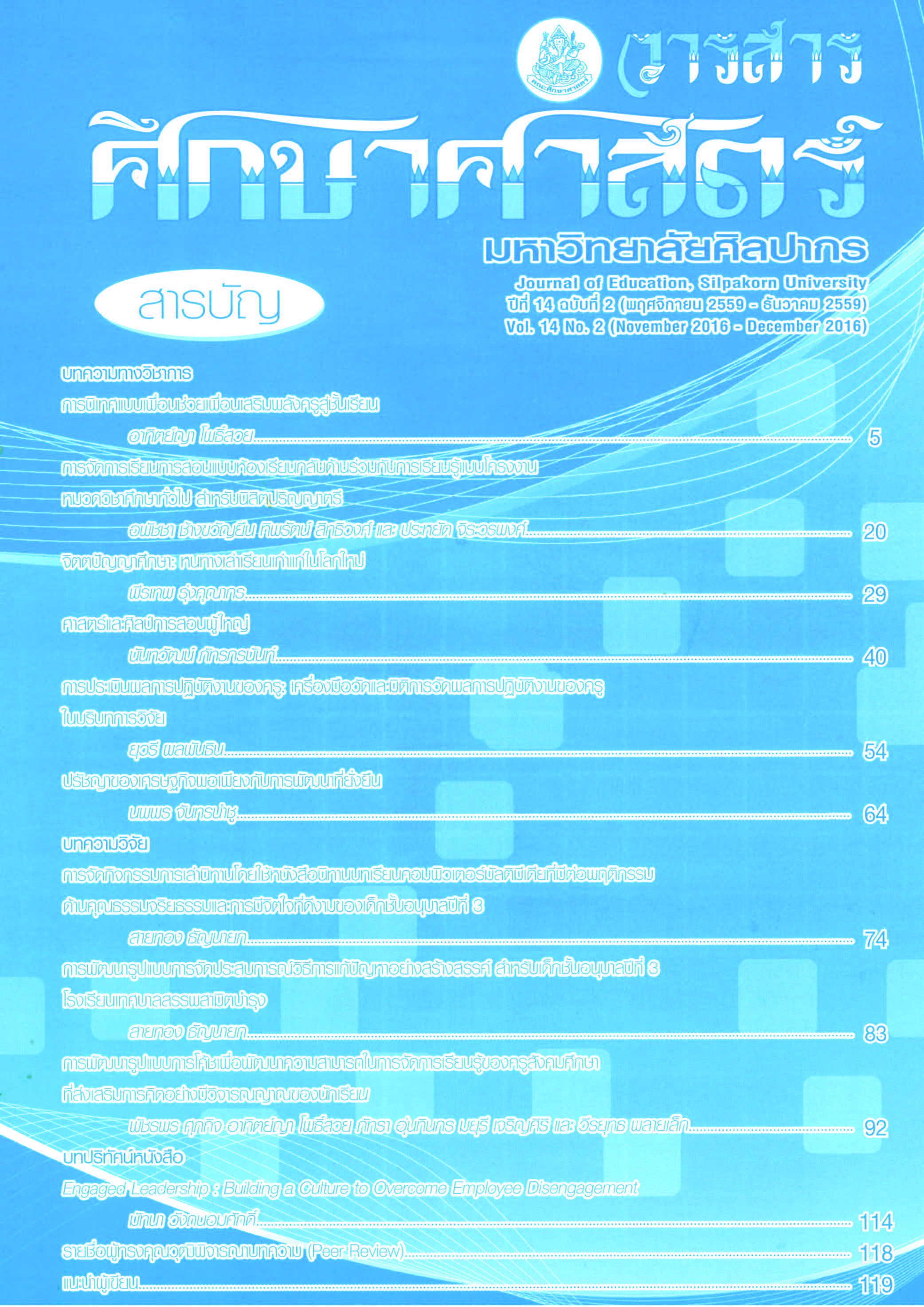การพัฒนารูปแบบการจัดประสบการณ์วิธีการแก้ปัญหาอย่างสร้างสรรค์สำหรับเด็กชั้นอนุบาลปีที่ 3 โรงเรียน เทศบาลสรรพสามิตบำรุง
Main Article Content
Abstract
ผลการวิจัยพบว่า
1. ความสามารถในการแก้ปัญหาอย่างสร้างสรรค์ ของเด็กชั้นอนุบาลปีที่ 3 มี 5 ด้าน คือ ความสามารถด้านความเข้าใจปัญหา ความสามารถด้านการสืบค้นข้อมูล ความสามารถด้านการนำเสนอวิธีในการแก้ปัญหา ความสามารถด้านการปฏิบัติ และ ความสามารถด้านการประเมินผล
2. รูปแบบการจัดประสบการณ์การแก้ปัญหาอย่างสร้างสรรค์สำหรับเด็กปฐมวัย (The PISAA) 5 ขั้น คือ ขั้นที่ 1 การกำหนดปัญหา ขั้นที่ 2 การค้นหาความคิด ขั้นที่ 3 การเลือกกลวิธีการแก้ปัญหา ขั้นที่ 4 การลงมือปฏิบัติ และขั้นที่ 5 การประเมินผล
3. คุณภาพของรูปแบบการจัดประสบการณ์การแก้ปัญหาอย่างสร้างสรรค์ สำหรับเด็กชั้นอนุบาลปีที่ 3 จากการประเมินของผู้เชี่ยวชาย อยู่ในระดับมีความเหมาะสมมากที่สุด และประสิทธิภาพของรูปแบบการจัดประสบการณ์การแก้ปัญหาอย่างสร้างสรรค์ สำหรับเด็กชั้นอนุบาลปีที่ 3 โดยเปรียบเทียบ E1/E2 กับเกณฑ์ 80/80 มีค่าประสิทธิภาพโดยรวมเท่ากับ 86.67/85.78 ซึ่งมีประสิทธิภาพสูงกว่าเกณฑ์ 80/80 ที่ตั้งไว้
4. เด็กชั้นอนุบาลปีที่ 3/1 ที่เป็นกลุ่มตัวอย่าง ที่ได้รับการจัดประสบการณ์การแก้ปัญหาอย่างสร้างสรรค์ หลังการจัดประสบการณ์สูงกว่าก่อนการจัดประสบการณ์
The Development of Lesson Plans in Creative Problem-Solving for Third Year Kindergarten Students at Sappasamitbamrung School
The objective of this study was to develop the lesson plans based on the creativity in problem-solving for third year kindergarten. The researcher aimed to investigate the information which related with the students’ ability in creative problem-solving. To develop the lesson plans in creative problem-solving for third year Kindergarten students. To do the experiment by using the developed lesson plans in creative problem-solving. Moreover, to compare the students’ ability in creative problem-solving before and after using the developed lesson plans. The sample group was Kindergarten 3/1 of Sappasamitbamrung School, Pha Nakhon Si Ayutthaya City Municipality, during the second semester in 2014. The total was 30 students who came from purposive sampling method because the researcher taught these students. The instruments were 10 lesson plans in creative problem-solving for third year Kindergarten students and the observation in Students’ behavior based on creative problem-solving. The researcher analyzed by using T-test in One-Short Case Study.
The findings found that
1. The ability in creative problem-solving of the kindergarten3 divided in 5 factors; the ability in understanding the problem, the ability in searching the information, the ability in presenting the solutions, the ability in practicing, and the ability in evaluation.
2. There are 5 steps in the pattern of the experience of creative problem-solving for the kindergarten (The PISAA). Step1: Set of the problem, Step2: Thinking, Step3: Choosing the suitable solution, Step4: Practicing and Step5: Evaluation
3. The Quality in the pattern of the experience of creative problem-solving for the kindergarten3 from the expert’s evaluation is in the most suitable level. The effectiveness of the experience of creative problem-solving for the kindergarten3 analyses by comparing E1/E2 with the criteria 80/80 the result shows 86.67/85.78 which express the higher score than the criteria 80/80
4. The kindergarten3/1 was the sample which got more experience in creative problem-solving after training


